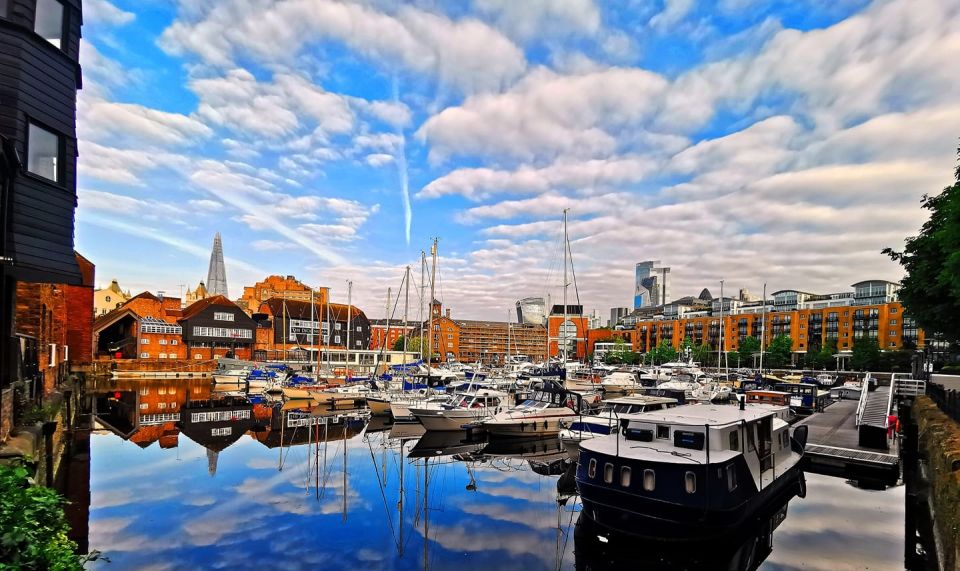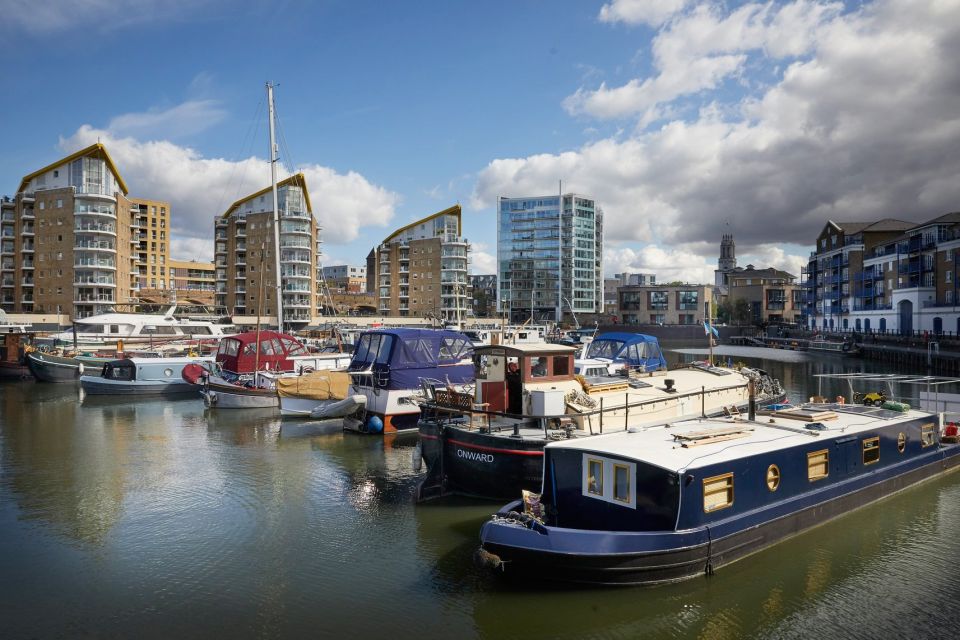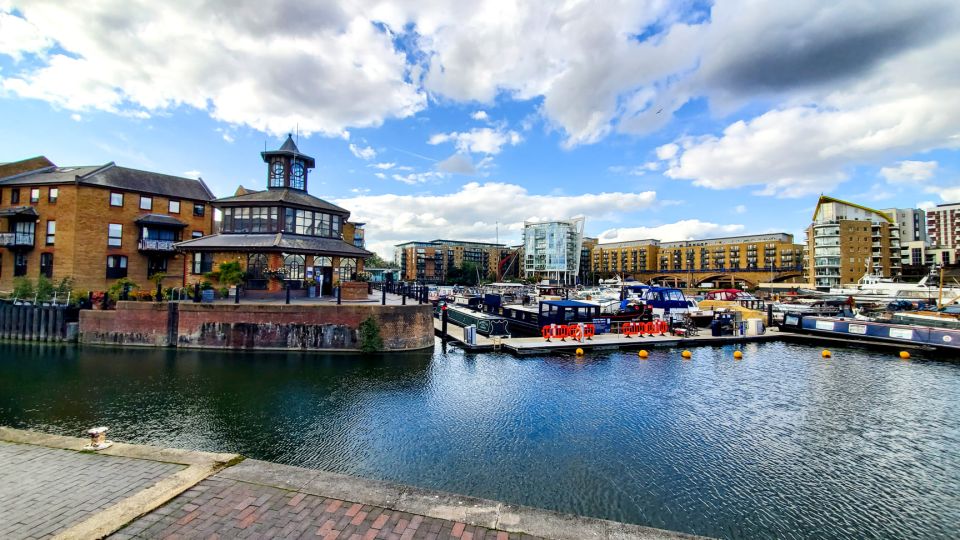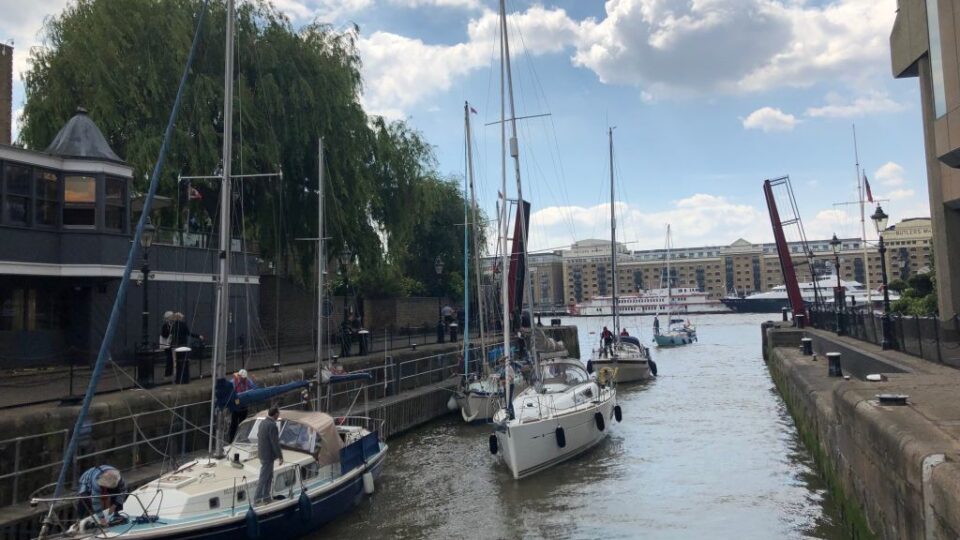Living on a Boat in London: What you Need to Know (Best Liveaboard Marinas, Costs, etc)
With rising property prices and rents in London, more people are opting for a home on the water rather than on land. If they could wake up to the sound of waves lapping against the boat and seagulls fluttering overhead, many individuals might consider giving up their land-based lives and moving onboard. Many people, sailors, and non-sailors alike are drawn to the liveaboard lifestyle. And, thousands of people have already chosen the liveaboard lifestyle over the hustle and bustle of city life. So, in this article, I’m going to give you information about the liveaboard life in London, the marinas, and general costs. If you’re interested keep reading!
Information about the Liveaboard Life in London
When you arrive in London by water, something spectacular happens. The city will never be the same again. It’s opened up by the river. Following its twists and turns from the sea, you realize that it is the reason London exists. It was founded on Ludgate Hill to trade with the rest of the world. London is an appealing city to live in for many, and boaters have been particularly attracted to it.
London’s boaters are fond of remarking on how congested the canals are now compared to ten, or twenty years ago. And, the timeline begins whenever they moved off the land. Then there’s the great toilet debate: are composting toilets truly odorless? What is the most effective approach to speed up the process? Is it better to use coffee grounds, sawdust, or peat? To someone’s eye, life on boats appears to be monotonous and exhausting. Some consider that it’s a haven for folks who enjoy working with power tools and activists with far-fetched ideas about green living. However, with an estimated 15,000 people living on boats in the UK, there are certain benefits.
According to the Canal River Trust and the Inland Waterways Association, the number of registered houseboats in London has more than quadrupled since 2012, to around 5,000 presently. Growth is expected to be 35-52% by 2022. Many new boaters have moved to the canals after being priced out of the capital’s housing market. However, there are people who have made a wise decision and have no plans to return to land. According to the Canal & River Trust, more individuals than ever are opting to live afloat on England’s canals, with 35,000 Britons presently doing so. Boatbuilders and merchants have also reported higher demand, with more boat licenses given this year than ever before.
The main motivations that lead people to live aboard a boat in London are affordability, the alternative lifestyle, and the sense of being closer to nature. The growth of interest and excitement for boating in London provides many benefits and opportunities for local communities and companies. But, it also poses significant issues for London boaters and communities. For instance, in London, it is extremely difficult to find an affordable and permanent mooring. Security is another important consideration there as high levels of crime have been reported in towpaths.

>>Also Read: Best Boating Destinations in the UK
Licenses for Liveaboards in London
Keep in mind that in order to live on a houseboat in London, you’ll need a mooring license. This comes in two varieties: short-stay and long-stay. Both are priced differently and are determined by the length of your boat as well as the length of your stay. The Canal and River Trust provides a short-stay mooring license, which costs roughly £550 depending on the length of the boat. Because you only have a short-stay mooring permit, you must relocate your boat two miles upstream every two weeks. Long-stay mooring permits differ by location since some are more attractive than others. Marinas and private yacht clubs offer these, which allow the owner to stay in one spot for a specific amount of time.
A leisure mooring — a long-term license to berth a boat but without the permission to live aboard – can take up to a year to get. It is famously difficult to get a residential mooring in London. More and more people are competing for fewer slots each year. This leads to exploitative landlords renting “slum-style” boat rooms on the one hand, and exorbitant costs for private moorings on the other. If they issue you a residential license, it will cost you £4,000 per year. And, this is a tiny thing to pay for a riverside location in zone 2 – even with council tax on top.
For continuous cruisers, the difficulty of finding a mooring in London is a major problem. Most people have come to accept it as “part of the package. But, they believe that there is more to be done so as to address the issue. One of the top proposals is to use parts of the canals that could be converted into mooring locations. Another is to tighten up the mechanisms for enforcing the restrictions. Moreover, it is obvious that a small number of boaters (particularly continuous cruisers) are physically or financially vulnerable (not simply because of Covid). And, as a result, may be unable to relocate their boat. The boating community is aware of its most vulnerable members. It also advises prudence when making judgments about enforcement processes. Or, anything else that may have an influence on boaters’ lives and homes.

>>Also Read: Best Sailing Destinations in the UK
Best Liveaboard Marinas in London
- Alexandra Yacht Club, The Cliffs, Southend-on-sea, Essex
- Halcon Marine, Canvey Island, Essex
- The Thames Estuary Yacht Club, Essex
- Brentford Dock Marina, Brentford
- Cadogan Pier, Chelsea Embankement
- Chas Newens Marine Co, The Boathouse, Putney
- Chelsea Harbour Marina, Chelsea Harbour
- Chiswick Pier Trust, Corney Reach Way, Chiswick
- Gallions Point, Greater London
- Poplar Dock, Greater London
- Limehouse, Greater London
- South Dock, Greater London
- Hermitage Community Moorings, London
- Imperial Wharf Marina, London
- Saint Katharine Docks Marina, Greater London
- Eel Pie Boatyard, Eel Pie Island, Twickenham
- Swan Island Harbor, Twickenham
- Erith Yacht Club, Kent
- Gravesend Embankment Marina, Gravesend
- Teddington Harbour, Middx
- W Hammerton & Co, Middlesex
- Wandsworth Riverside Quarter, London
Issues about the Liveaboard River Life
A major issue is that a sailboat’s keel/underside would not fit in the rivers. The Thames is alright, but anything smaller will get you stranded. Not to mention that the canal system appears to have an issue where someone leaves a lock open and the section drains to practically nothing. This causes your keel to scrape and the boat to tip as the water level drops. Keep in mind that wooden sailboats require a lot of upkeep, and repairs are costly. FRP or steel are the best options. Also note that the Thames and its tributaries are rivers, not bays, thus draft may be an issue. Because you’re most likely limited to ballasted boats rather than keelboats, your sailing performance will be affected.
If you want to live aboard rather than sail, a barge is likely to be more comfortable and cost-effective. So, if you want to dock in rivers or shallow locations, you can’t use a conventional single keel with ballast. And, this is what the majority of sailing yachts have. However, there are certain boats that will perfectly suit your needs. Twin keels are nice as well as a swing keelboat. Many more variants are available with swing keels. Bear in mind that in most portions of the Thames and its extensions, a barge is the boat you should live on. You must also be aware that you will be moving on a frequent basis. Every two weeks, they expect you to traverse 2 miles on average.
If you cruise frequently, you must move every two weeks and cover a specific amount of ground each year. This is something that many people enjoy doing because it allows them to see different parts of London and meet new people. On the water, the community is very strong and welcoming.
Amenities and the Liveaboard Life in London
The minimal amenities accessible to the enormous network of boaters is another important issue. More water points, bins, and toilet disposal places would relieve congestion at service points. And, they also prevent pollution of the waterways.
It’s important to note that Covid-19 has had a wide range of effects on boaters, some of which have been good. The boating community has become stronger as a result of the government’s movement limitations. Many people have taken advantage of the opportunity to build deeper bonds with their neighbors, which would be difficult under normal conditions. Boaters have also reported feeling more secure knowing that other boaters are nearby during the day. Furthermore, the persistence of remote working in some businesses is thought to have a longer-term influence. More boaters may move further out of London to peaceful areas if they no longer need to moor near to their work. During the pandemic, boaters have also faced difficulties. Increasing the amount of time spent on the boat depletes resources such as water and electricity. For some boaters, busier towpaths have also felt obtrusive.
Water, electricity, and the bathroom are the primary problems. You have a water tank that you must replenish at water stations along the canal and river. The size of your tank determines how frequently this should be done. Because electricity is limited, you must determine how many batteries will suffice for the items you wish to power. Toasters, curling irons, and hair dryers are prohibited because they consume too much power too quickly. Consider having four leisure batteries and two enormous solar panels. These will supply you with adequate electricity to operate lights, charge phones, and computers for two-thirds of the year. You may need to operate the motor to charge the batteries occasionally during the winter months. But, you have gauges to tell you when this is necessary. Additionally, every time you move the engine, it charges the batteries.
Finally, there’s the toilet issue. After weighing all of the alternatives, many go for a composting toilet. Chemical toilets and pump-out toilets are the other basic options. The chemical toilet must be emptied into an Elsan container (a big drain point with a hose that connects to the sewers that are located along the canal). These contain a lot of chemicals and emit a bad odor when you empty them.
The pump-out is the least time-consuming alternative since it’s like a regular toilet with a tank that needs to be emptied every few weeks. The disadvantage is that you must pay each time you wish to empty it, and you must relocate your boat to a pump-out station. Note that there are no toxic chemicals in a composting bin, and you can carry a biodegradable garbage bag to the bin once a month. There is no mess, no odor, and no fuss. But, in the end, it’s up to your preferences.
The hardest part of living aboard a boat is definitely strolling back down dark towpaths alone at night, anxious about your boat’s security. Unfortunately, central London may be just as dangerous as the outskirts when it comes to crime.

>>Also Read: 10 Reasons Why You Should Live on a Sailboat
Boat Considerations
Keep in mind that if you don’t still owe a boat it will take you several months to find the appropriate one. It’s critical to determine how you want to use the space. There’s also the practical side of things to consider, such as how you’ll heat your boat and water, and how you’ll charge your batteries. There’s a lot to consider, and there are numerous possibilities. When it comes to learning the ropes, you can talk to a lot of people, and internet forums can be quite helpful.
Bear in mind that there is more maintenance to be done than in a house, such as keeping an eye on your battery and water levels. Also, you have to make sure you replace your fuel canisters when they run out, keeping an eye on your stove fuel levels in the winter, and making sure you have enough diesel. But, once you’re up and running, it all becomes second nature. Of course, liveaboard life is not always pleasant. Having to move in the rain or strong winds, and being able to do DIY repairs as well as compromise with small spaces are some of the main issues. Living on a boat requires a lot of effort and will, and it’s not for everyone.
Make sure you’ve done your research before buying a boat or choosing a marina to live in. It’s also important not to be too hard on yourself. You’ll never know everything, but as long as you ask for guidance and learn as you go, people will gladly assist you. If you’re going to cruise, consider the size of the boat you desire.
It’s alright if you want a giant wide beam, but can you navigate the Islington tunnel securely with one? Because the canals are busier than ever, you may want to consider purchasing a boat that you can easily moor. A 30ft narrowboat can easily find a mooring site in central London, whereas a 60ft wide beam boat cannot. This is because you have to move it as well as live in it. It’s a wonderful life, with the city, the countryside, the friends, and the cruising, but it’s also a lot of work.
Living on a Boat in London – The Bottom Line
In terms of age, occupation, living circumstances, and interests, liveaboard life in London attract a diverse group of people. At the same time, the majority of boaters share the desire to live a more alternative lifestyle that is closer to nature and more economical. Boaters have a common experience of the outdoors, the freedom that comes with sailing, and the practicality of day-to-day life, resulting in a strong community of like-minded people. It’s important to note that liveaboard life in London is not for everyone. Individuals who persist with boating despite the daily struggles tend to profit more from the tranquility, beauty, and independence of being on the water. But, the financial rewards appear to be less obvious. Indeed, boaters who do not appreciate the lifestyle and just want to save money will find it difficult to cope with some of the more difficult parts of the liveaboard life.
Financial concerns frequently impact the choice to relocate abroad, whether as a result of an inheritance or a loan or as a result of job loss and the inability to pay high rental prices. And, there’s a strong desire to sail freely in nature and be a continuous cruiser rather than pay for a mooring. With permanent mooring, many characteristics of the continuous cruiser lifestyle are not considered accessible. This is due to the fact that moorings in London are very expensive and rare.
Some people have a good cause for not following the rules. Continuous cruisers are aware of the moving restrictions and claim to follow them as closely as possible, albeit it appears that this is more difficult for those with children. Note that the biggest source of concern among liveaboards is criminality. Among boaters, the potential of theft and mugging on towpaths is quite real, with many having personally suffered a boat break-in. To combat criminality on the towpaths, the canal authority is supposed to collaborate with the larger community. Lastly, finding a liveaboard berth for £200/month in London is nearly impossible. So, you need to do some research on cost and the marina’s regulations.
There are other challenges, such as learning where the nearest supermarket is when you move somewhere new, but overall, the benefits exceed the downsides. It can be a wonderful way of life since you enjoy being in nature, and being on a boat puts you closer to it. This is also the closest you can get to the countryside if you work in London. Of course, living aboard in London is exciting, and most liveaboard communities are welcoming and vibrant. But, like everything in life, there are pros and cons to every choice. What you have to do is determine your needs, do thorough research, and if you’ve come to the conclusion that the liveaboard life is for you then just go for it!
